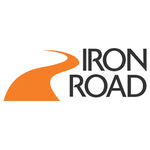With a Rocketing Iron Ore Price, it could be IRD’s Time
Company overview
Iron Road Ltd (ASX:IRD) is the 100% owner of the Central Eyre Iron Project (CEIP), a well advanced, iron ore mining, beneficiation and infrastructure development on the Eyre Peninsula, South Australia.
One of several things working in IRD’s favour is its Board. There aren’t too many boards that have a former BHP Chairperson residing. IRD does and that is ideal for any aspiring iron ore company.
IRD’s project features a world class, coarse grained, magnetite ore body with a 4.5 billion tonne mineral resource and definitive 3.7 billion tonne ore reserve estimate - the largest of any magnetite ore reserve in Australia.
IRD has an annual production target of 12 Mtpa (dry) at a grade of 66.7% iron (considered premium high-grade), over an initial 22 year mine life. The life of mine concentrate is 250 Mt.
IRD’s most recent financial modelling of the project demonstrated a NPV of US$2.6BN. That’s assuming a US$120/dmt price for high-grade iron ore (65% Fe) – which in the current market is a conservative figure, well below recent sustained spot prices over US$200/dmt.
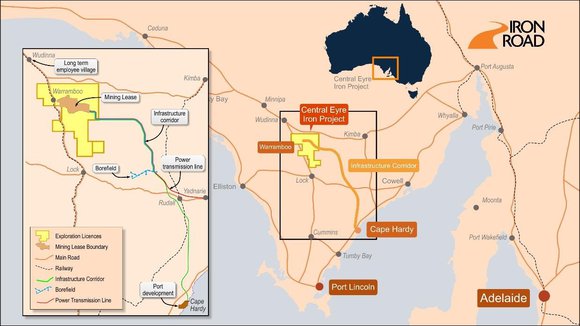
Along with the CEIP, IRD is developing multi-user, multi-commodity port infrastructure, known as Cape Hardy, a valuable asset in its own right given that it will be a port that can handle Capesize ships, facilitating the export of a wide range of bulk commodities, including IRD’s iron ore.
The $250M Panamax capable port stage I project is intended to be primarily financed by development partners Macquarie Capital and to a lesser extent, Eyre Peninsula Cooperative Bulk Handling (EPCBH). The Cape Hardy port precinct is also supported by a $25M Federal Government grant commitment.
Iron Road maintains 100% ownership of the 1100 hectare port site and the CEIP, with the potential to farm-out or divest part of the CEIP project to strategic partners in order to drive both equity and debt financing for the project and facilitation of offtake agreements.
Of note here is the involvement of Cape Hardy Stage I Project Chair and former Premier of South Australia Rob Kerin, who considers the Cape Hardy port project a once-in-a-generation opportunity to provide the key infrastructure that will help the Eyre Peninsula realise that potential.
In addition, along with The Hydrogen Utility (H2U), IRD has plans to develop a large-scale green hydrogen production and export hub at Cape Hardy, extending over an area of 200ha.
IRD’s three key assets are as follows:
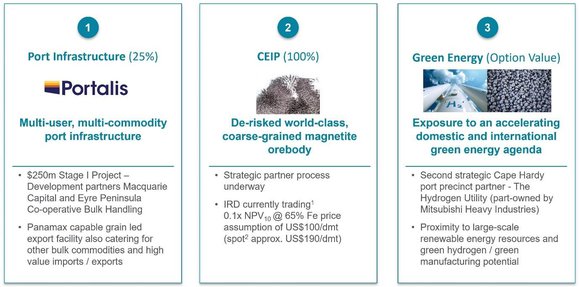
IRD Investment highlights
- 100% owner of an advanced iron ore project with a 3.7 billion tonne ore reserve estimate and NPV of US$2.6BN that could be the next logical magnetite project after Fortescue Metals Group (ASX:FMG)’s Iron Bridge.
- IRD’s major shareholder with a combined holding of over 70% are the Sentient Global Resources Funds. Sentient is recognised as patient, long-term focused and committed business builders in the resources industry across the globe. The majority of Sentient Fund IV’s US$1.3BN capital was raised from US institutions. Sentient were early investors in the advent of coal seam gas developments in Queensland via Queensland Gas (QGC) which was ultimately taken over by British Gas in a multi-billion dollar transaction. Similarly, Sentient were early investors in Andean Resources in Argentina which was also acquired in another multi-billion dollar transaction by gold industry major Goldcorp. Sentient has had a position in IRD since providing seed capital prior to IRD’s 2008 IPO.
- The iron ore price is expected to continue to be supported by steel intensive industry activity globally, especially in the infrastructure and construction sectors around the world.
- Management has a thorough understanding of the orebody having completed 160,000 metres of diamond drilling and metallurgical testing in establishing Australia’s largest magnetite ore reserve.
- With strong support at federal and state government levels, meeting milestones such as final permitting and designs could well be streamlined with parallel financing plans.
- The Panamax capable port infrastructure joint venture and ownership terms appear favourable, particularly with IRD retaining the right to hold up to 25% of the port project at financial close while maintaining 100% ownership of the 1100 hectare port site and the CEIP.
- With multiple stakeholders such as agricultural bodies, infrastructure investors and the corporate banking sector, as well as the mining industry all having a vested interest in the success of the iron ore project one would expect an affirmative approach in making it happen. There is certainly significant upside from the government’s perspective from job creation alone.
- As a budding ESG company working closely with H2U on its green hydrogen project, there should be considerable scope for a share price rerating.
IRD holds Australia’s largest magnetite ore reserve
According to Argus, the iron ore spot price to North China hit a record US$235.55 a tonne on May 12.
At an exchange rate assumption of US$0.75, an increase in the high-grade 65% Fe commodity price from US$100/dmt to US$120/dmt increases the NPV10 value from US$1.49 billion to US$2.95 billion. If you look at this in the context of the current spot price of circa US$200 per tonne, the metrics look better than compelling – they are mind-blowing set against Iron Road’s market capitalisation of approximately $225 million.
As a guide, the Net Present Value based on IRD’s development strategy is approximately US$1.2 billion based on a price of US$100 per dry metric tonne and an Australian dollar/US dollar exchange rate of US$0.80, slightly above the current spot price of about US$0.78.
The below table shows how the financial metrics look.
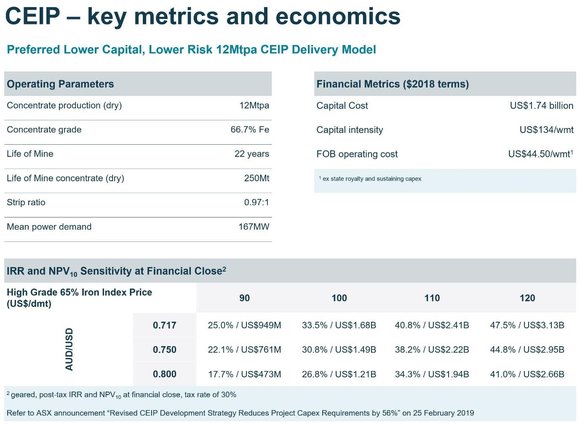
Cape Hardy Port project: Long life project leveraged to growth opportunities
A planned export facility at Cape Hardy is designed to be South Australia’s first Capesize capable port and will be developed over a number of stages.
IRD’s focus over the next 6-12 months includes progressing development of Cape Hardy port precinct infrastructure, attracting investment in the Central Eyre Iron Project (CEIP) and monetising early stage green hydrogen partnerships.
The map below shows the exact location of the proposed port.
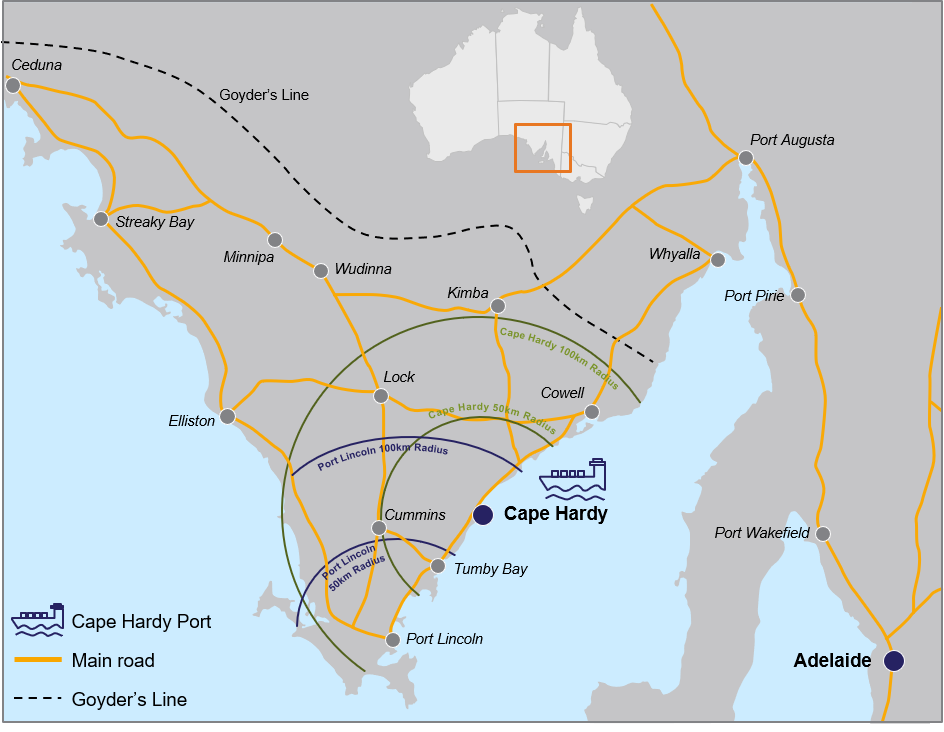
The mine and port are planned to be linked by an infrastructure corridor with an efficient road haulage option (dual-powered road trains) for iron concentrate transport over a distance of approximately 140km. This haulage length is considerably lower than most haulage distances in Western Australia. The corridor includes a powerline and water pipeline over part of its length.
Ore will be sourced for the port from a single open pit mine using conventional truck and shovel methods.
The beneficiation plant located at the mine site is expected to produce a high quality, low impurity iron concentrate that will serve as a clean, superior blending product for steel mill customers.
Although CEIP production options range from 12 to 24 million tonnes per annum (Mtpa), the lighter capital, lower 12Mtpa production model released in February 2019 demonstrates highly competitive operating margins given an FOB operating cost of US$44.50/wmt (Life of Mine) and remains the preferred model to attract CEIP investment.
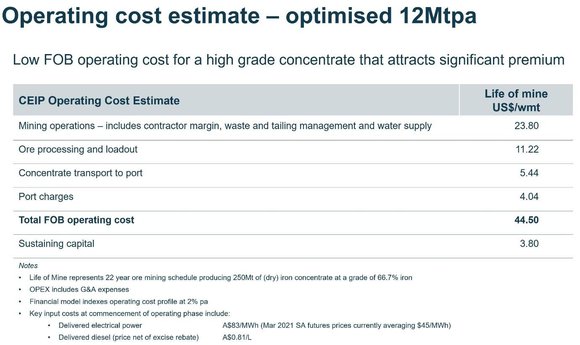
High profile partners stakeholders and partners
Infrastructure Australia has identified the potential for the proposed Cape Hardy port to ultimately integrate to the Australian National Rail Network, which would provide the basis for a world class, multi-commodity, multi-user bulk shipment port that can service central and southern regional Australia. It also designates the infrastructure as a Priority Project for the nation.
IRD recently announced a Joint Development Agreement (JDA) with Macquarie Capital (part of Macquarie Group Ltd, ASX:MQG) and Eyre Peninsula Co-operative Bulk Handling (EPCBH), effectively an endorsement of the quality of the group’s asset base and its development potential.
The support from Infrastructure Australia was endorsed by the Federal Government in December 2019 by way of their $25 million grant commitment to assist in financing the development of the Cape Hardy port infrastructure.
The JDA provides the framework to advance development and financing plans for the proposed $250 million Cape Hardy Panamax capable multi-user, multi-commodity port facility.
IRD retains the right to hold up to 25% of the project at Financial Close while maintaining 100% ownership of the 1,100 hectare port site and the Central Eyre Iron Project (CEIP).
Renewable energy sources - no longer a green dream
IRD owns 100% of the 1,100 ha Cape Hardy port site. Further long-term opportunities for Cape Hardy revolve around its proximity to large-scale renewable energy resources and potential for green hydrogen development.
The South Australian Government has released a prospectus identifying the opportunity for green hydrogen exports to be shipped from a greenfield port in the Cape Hardy region of the Eyre Peninsula.
The prospectus demonstrates how the State can prosper from rising global demand for hydrogen, a commodity that is forecast to contribute as much as $1.7 billion and 2,800 jobs to the national economy by 2030.
The hydrogen export prospectus recognises the ideal location of Cape Hardy on the Eyre Peninsula, connecting renewable resources with an indicative distance to the port of 60 kilometres, and the potential for small-scale and large-scale green hydrogen export ranging from 60,000 to 250,000 tonnes per annum.
On this note, S&P Global Market Intelligence outlined the following on 13 January 2021:
" Mitsubishi Heavy Industries Ltd.'s investment in South Australia's hydrogen sector has led to plans for an iron ore "green pellet" plant at Iron Road Ltd.'s Cape Hardy port site. It could also pave the way for hydrogen technology to aid Japan's and South Korea's steel industry decarbonization ambitions.
"Iron Road told the ASX on Jan. 12 that it recently extended its 2019 heads of agreement and project development accord with Australian renewable energy integrator The Hydrogen Utility, or H2U, by a year.
"H2U has identified that a minimum 200-hectare footprint on the Cape Hardy site is needed for a proposed green manufacturing precinct.
"H2U attracted Mitsubishi Heavy in November 2020 as a partner for its own A$240 million Eyre Peninsula Gateway project at Port Bonython."
Exceptional Board and Management drives project forward
Sitting on the IRD board include two founders of the Sentient Global Resources Funds: Non Executive Chairman Peter Cassidy and Non-Executive Director Ian Hume. The four funds ultimately raised a total of US$2.7BN of capital. Both were responsible for the successful early stage and very high returning investments in Queensland Gas and Andean Resources.
Management is made of up of the following high level figures:
CEO - Larry Ingle
A thirty year industry veteran, Larry cut his teeth with various global companies including Gold Fields of South Africa, Lesotho Highlands Project Contractors (JV), Barrick Gold Corporation and Rio Tinto. He has been with IRD since inception in 2008.
Non Executive Director - Jerry Ellis
Mr Ellis’ career includes three decades at BHP, chairing the company from 1997 to 1999. He also served on the boards of a number of listed companies and governing bodies including Newcrest Mining, Aurora Gold, the International Copper Association, Australia and New Zealand Banking Group, the International Council on Metals and the Environment and the American Mining Congress.
Project Chair - Cape Hardy Port Project (Portalis) - Rob Kerin
Former Premier of South Australia, Rob serves as Project Chair for the Cape Hardy Stage 1 port project. Rob is also Executive Chair of Primary Producers SA, Chairman of Regional Development SA, Director of South Australian National Football League, Deputy Chair Australian Country Football Council, Deputy Chair of Variety (SA) and Board member of Brand SA.
Executive Director, Glen Chipman
Mr Chipman has 20 years of combined industry, mineral economics and equity capital markets experience and also represents the major shareholder having been seconded to IRD since 2013. He has relevant sector and transactional experience having served on the board of Brazilian high quality 4Mtpa iron ore producer Ferrous Resources until it was acquired by industry major Vale in 2019.
Impact of macro and industry dynamics
- Since 2014, greenfield projects with higher capital intensity requirements have experienced financing challenges in a lower global growth environment. However, over the past six months, iron ore fundamentals have tightened appreciably and a more positive longer term price outlook has resulted in advanced development projects such as the CEIP being viewed in a more positive light.
- Global steel demand (ex-China) is experiencing a recovery and a pathway back to normalisation during 2021. This trend along with continued strong demand in China has accelerated in recent months, driving iron ore prices to record highs in April/May.
- Stimulus packages introduced by the world’s largest economic powers are pitched at driving investment at a public and private level, particularly in the areas of infrastructure development and large-scale building projects, initiatives that are likely to underpin strong steel demand growth for some years.
- The shift to renewable energy and production of ‘green’ resources, particularly across the carbon-heavy metals industries is in full swing, and only recently iron ore magnate Andrew Forrest flagged the potential of producing green iron ore and steel (driven by hydrogen energy), even highlighting the potential for such projects in South Australia due to regional advantages.
- Investors are gravitating quickly to ESG companies with billions of dollars being poured into ESG bonds, as well as individual enterprises that carry this profile. If IRD could fulfil its green hydrogen play, it could be a beneficiary of broader investment.
Our view
Leverage off IRD’s past investment: IRD has spent around $175 million since 2008 to get the company to where it is today, and at its current $150M market cap we feel like we are getting in at a very good valuation at the right time as iron ore starts to run again.
Strong macro theme: We expect IRD will perform very well if the iron ore price strength continues in the global post pandemic construction boom.
Realistic path to market: A port development project for shipping its iron ore is already well progressed since 2008: IRD is in the right place, at the right time with an advanced project.
Institutional Backing: Private equity firm Sentient Global Resources Funds owns 72% of IRD and has been a very long term holder - which means there aren’t many shares available free float on the market. Macquarie Capital is also on IRD’s register as a holder of Warrants.
Co-investing alongside big, cashed up institutions makes us feel confident in the investment over the long term.
Cash in Bank: IRD is debt free and has a healthy cash balance following recent capital raises since December 2020 that brought in $16M. We participated in the most recent placement at 21.5 cents, and so did IRD’s Directors in the SPP on the same pricing terms.
Unknown and undervalued: We like IRD because it’s currently one of the lesser known stocks we have seen on the ASX. IRD appears to have done very little promotion to gain new investors over the last few years, hence offering a good chance of share price upside as they start to roadshow the story.
Net Present Value: IRD’s most recent financial modelling of the iron ore project demonstrated a NPV of US$2.6BN at a high-grade iron ore price (65% Fe) of US$120/t.
‘Green Hydrogen’ generates a lot of attention: Even Twiggy’s Fortescue is looking at it after making billions of dollars in iron ore profits.
Catalysts
- Sell-down of a partial interest at the CEIP level to a strategic industry partner.
- Continued development progress by Portalis / Macquarie in relation to Stage I Cape Hardy.
- Building on the green hydrogen partnerships already established.
- Meeting milestones relating to the planning of potential green energy export infrastructure from Cape Hardy.
- Secondary approvals for the preferred lower capital, lower risk 12 million tonnes per annum CEIP model.
- Attracting strategic partners and negotiating offtake agreements.
- COVID should create significant demand for steel, and in turn iron ore. This could result in IRD gaining further value recognition as tight iron ore fundamentals sustain prices at higher levels than market expectations.
THE BULLS SAY
- Securing a strategic industry partner for the CEIP will be an important development and one would expect that this can be achieved given significant growth in demand and offtake interest for the group’s high-grade product.
- The benefits of linkages to future hydrogen opportunities could provide a competitive advantage.
- The aforementioned would further strengthen the group’s ESG position, making it even more attractive for investors.
- Strong support at corporate, federal government and state government levels indicates that there are multiple stakeholders and regulators that want the project to succeed - an important factor when it comes to issues such as permitting, financing and construction.
- The Stage I joint venture and ownership terms with regard to the port work in the favour of investors, particularly with IRD retaining the right to hold up to 25% of the project at financial close while maintaining 100% ownership of the 1100 hectare port site and the CEIP.
- The current spot price for 65% Fe is now well in excess of US$200/dmt, making IRD’s metrics that are based on a 65% Fe price of circa US$100-120 per tonne look very conservative.
THE BEARS SAY
- Capital costs of the iron ore project are large at US$1.74BN. Even with a farm out partner, funding for the capital cost remains a risk.
- A downturn in global infrastructure development and the broader construction sector would normally result in reduced demand for steel, and in turn iron ore, effectively placing downward pressure on prices.
- Aside from swings in iron ore prices, another key factor to be mindful of would be an appreciation in the Australian dollar against the US dollar as this negatively affects the Australian dollar income from iron ore sales.
- Though seemingly unlikely, the failure to achieve the few regulatory approvals still required and/or securing a strategic partner would have a negative impact on the company.
General Information Only
S3 Consortium Pty Ltd (S3, ‘we’, ‘us’, ‘our’) (CAR No. 433913) is a corporate authorised representative of LeMessurier Securities Pty Ltd (AFSL No. 296877). The information contained in this article is general information and is for informational purposes only. Any advice is general advice only. Any advice contained in this article does not constitute personal advice and S3 has not taken into consideration your personal objectives, financial situation or needs. Please seek your own independent professional advice before making any financial investment decision. Those persons acting upon information contained in this article do so entirely at their own risk.
Conflicts of Interest Notice
S3 and its associated entities may hold investments in companies featured in its articles, including through being paid in the securities of the companies we provide commentary on. We disclose the securities held in relation to a particular company that we provide commentary on. Refer to our Disclosure Policy for information on our self-imposed trading blackouts, hold conditions and de-risking (sell conditions) which seek to mitigate against any potential conflicts of interest.
Publication Notice and Disclaimer
The information contained in this article is current as at the publication date. At the time of publishing, the information contained in this article is based on sources which are available in the public domain that we consider to be reliable, and our own analysis of those sources. The views of the author may not reflect the views of the AFSL holder. Any decision by you to purchase securities in the companies featured in this article should be done so after you have sought your own independent professional advice regarding this information and made your own inquiries as to the validity of any information in this article.
Any forward-looking statements contained in this article are not guarantees or predictions of future performance, and involve known and unknown risks, uncertainties and other factors, many of which are beyond our control, and which may cause actual results or performance of companies featured to differ materially from those expressed in the statements contained in this article. S3 cannot and does not give any assurance that the results or performance expressed or implied by any forward-looking statements contained in this article will actually occur and readers are cautioned not to put undue reliance on forward-looking statements.
This article may include references to our past investing performance. Past performance is not a reliable indicator of our future investing performance.

